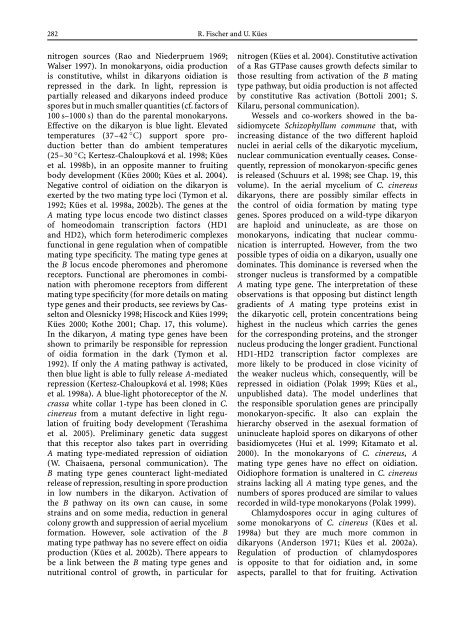Growth, Differentiation and Sexuality
Growth, Differentiation and Sexuality
Growth, Differentiation and Sexuality
You also want an ePaper? Increase the reach of your titles
YUMPU automatically turns print PDFs into web optimized ePapers that Google loves.
282 R. Fischer <strong>and</strong> U. Kües<br />
nitrogen sources (Rao <strong>and</strong> Niederpruem 1969;<br />
Walser 1997). In monokaryons, oidia production<br />
is constitutive, whilst in dikaryons oidiation is<br />
repressed in the dark. In light, repression is<br />
partially released <strong>and</strong> dikaryons indeed produce<br />
spores but in much smaller quantities (cf. factors of<br />
100 s–1000 s) than do the parental monokaryons.<br />
Effective on the dikaryon is blue light. Elevated<br />
temperatures (37–42 ◦ C) support spore production<br />
better than do ambient temperatures<br />
(25–30 ◦ C; Kertesz-Chaloupková et al. 1998; Kües<br />
et al. 1998b), in an opposite manner to fruiting<br />
body development (Kües 2000; Kües et al. 2004).<br />
Negative control of oidiation on the dikaryon is<br />
exerted by the two mating type loci (Tymon et al.<br />
1992; Kües et al. 1998a, 2002b). The genes at the<br />
A mating type locus encode two distinct classes<br />
of homeodomain transcription factors (HD1<br />
<strong>and</strong> HD2), which form heterodimeric complexes<br />
functional in gene regulation when of compatible<br />
mating type specificity. The mating type genes at<br />
the B locus encode pheromones <strong>and</strong> pheromone<br />
receptors. Functional are pheromones in combination<br />
with pheromone receptors from different<br />
mating type specificity (for more details on mating<br />
type genes <strong>and</strong> their products, see reviews by Casselton<br />
<strong>and</strong> Olesnicky 1998; Hiscock <strong>and</strong> Kües 1999;<br />
Kües 2000; Kothe 2001; Chap. 17, this volume).<br />
In the dikaryon, A mating type genes have been<br />
shown to primarily be responsible for repression<br />
of oidia formation in the dark (Tymon et al.<br />
1992). If only the A mating pathway is activated,<br />
then blue light is able to fully release A-mediated<br />
repression (Kertesz-Chaloupková et al. 1998; Kües<br />
et al. 1998a). A blue-light photoreceptor of the N.<br />
crassa white collar 1-type has been cloned in C.<br />
cinereus fromamutantdefectiveinlightregulation<br />
of fruiting body development (Terashima<br />
et al. 2005). Preliminary genetic data suggest<br />
that this receptor also takes part in overriding<br />
A mating type-mediated repression of oidiation<br />
(W. Chaisaena, personal communication). The<br />
B mating type genes counteract light-mediated<br />
release of repression, resulting in spore production<br />
in low numbers in the dikaryon. Activation of<br />
the B pathway on its own can cause, in some<br />
strains <strong>and</strong> on some media, reduction in general<br />
colony growth <strong>and</strong> suppression of aerial mycelium<br />
formation. However, sole activation of the B<br />
mating type pathway has no severe effect on oidia<br />
production (Kües et al. 2002b). There appears to<br />
be a link between the B mating type genes <strong>and</strong><br />
nutritional control of growth, in particular for<br />
nitrogen (Kües et al. 2004). Constitutive activation<br />
of a Ras GTPase causes growth defects similar to<br />
those resulting from activation of the B mating<br />
type pathway, but oidia production is not affected<br />
by constitutive Ras activation (Bottoli 2001; S.<br />
Kilaru, personal communication).<br />
Wessels <strong>and</strong> co-workers showed in the basidiomycete<br />
Schizophyllum commune that, with<br />
increasing distance of the two different haploid<br />
nuclei in aerial cells of the dikaryotic mycelium,<br />
nuclear communication eventually ceases. Consequently,<br />
repression of monokaryon-specific genes<br />
is released (Schuurs et al. 1998; see Chap. 19, this<br />
volume). In the aerial mycelium of C. cinereus<br />
dikaryons, there are possibly similar effects in<br />
the control of oidia formation by mating type<br />
genes. Spores produced on a wild-type dikaryon<br />
are haploid <strong>and</strong> uninucleate, as are those on<br />
monokaryons, indicating that nuclear communication<br />
is interrupted. However, from the two<br />
possible types of oidia on a dikaryon, usually one<br />
dominates. This dominance is reversed when the<br />
stronger nucleus is transformed by a compatible<br />
A mating type gene. The interpretation of these<br />
observations is that opposing but distinct length<br />
gradients of A mating type proteins exist in<br />
the dikaryotic cell, protein concentrations being<br />
highest in the nucleus which carries the genes<br />
for the corresponding proteins, <strong>and</strong> the stronger<br />
nucleus producing the longer gradient. Functional<br />
HD1-HD2 transcription factor complexes are<br />
more likely to be produced in close vicinity of<br />
the weaker nucleus which, consequently, will be<br />
repressed in oidiation (Polak 1999; Kües et al.,<br />
unpublished data). The model underlines that<br />
the responsible sporulation genes are principally<br />
monokaryon-specific. It also can explain the<br />
hierarchy observed in the asexual formation of<br />
uninucleate haploid spores on dikaryons of other<br />
basidiomycetes (Hui et al. 1999; Kitamato et al.<br />
2000). In the monokaryons of C. cinereus, A<br />
mating type genes have no effect on oidiation.<br />
Oidiophore formation is unaltered in C. cinereus<br />
strains lacking all A mating type genes, <strong>and</strong> the<br />
numbers of spores produced are similar to values<br />
recorded in wild-type monokaryons (Polak 1999).<br />
Chlamydospores occur in aging cultures of<br />
some monokaryons of C. cinereus (Kües et al.<br />
1998a) but they are much more common in<br />
dikaryons (Anderson 1971; Kües et al. 2002a).<br />
Regulation of production of chlamydospores<br />
is opposite to that for oidiation <strong>and</strong>, in some<br />
aspects, parallel to that for fruiting. Activation

















